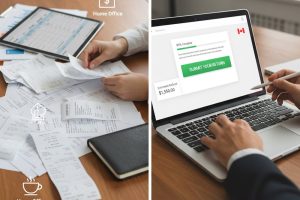Tax season in Canada often brings a mix of stress and anticipation. While many Canadians are eager to receive their refunds, not everyone knows how to maximize their return. Whether you’re an individual taxpayer or a small business owner, following the right strategies can help you receive the largest possible tax CRA refund.
In this guide, we’ll break down essential CRA tax refund tips, explore smart deductions, and offer practical tax filing advice to help get the most from your income tax return.
Understanding the CRA Refund Process
Before diving into tips, it’s important to understand how refunds work. When you file your taxes in Canada, the Canada Revenue Agency (CRA) calculates your total income, applies applicable credits and deductions, and compares the result with the taxes you’ve already paid. If you’ve overpaid, you’re entitled to a refund.
But here’s the catch: unless you claim all eligible credits, deductions, and expenses, you could leave money on the table.
Top CRA Tax Refund Tips for Individuals
1. Claim All Available Credits
The CRA offers a wide range of credits, many of which are often overlooked. Popular ones include:
-
Basic Personal Amount – available to everyone
-
Canada Workers Benefit (CWB) – for low-income earners
-
Tuition Tax Credit – for students
-
Disability Tax Credit (DTC) – for those with disabilities or caregivers
By knowing which credits apply to your situation, you can maximize tax refund Canada.
2. Use RRSP Contributions to Lower Taxable Income
Registered Retirement Savings Plans (RRSPs) are one of the most powerful tools for reducing your taxable income. Contributions made before the March 1 deadline can be claimed for the previous tax year, which lowers your tax burden and can result in a larger refund. If you’re looking for solid CRA tax refund tips, this one’s a classic for a reason.
3. Claim Work-from-Home Expenses
Since the pandemic, the CRA has allowed Canadians to claim home office expenses using a simplified flat-rate method or the detailed method. If you’ve worked remotely, don’t forget to include eligible costs like utilities, rent (if applicable), or office supplies.
4. Take Advantage of Medical Expenses
Many Canadians are unaware that medical expenses not covered by insurance may be deductible. This includes:
-
Dental services
-
Prescription medications
-
Physiotherapy
-
Certain mental health services
Keep your receipts and speak with a tax advisor to determine which expenses qualify.
5. Transfer or Carry Forward Unused Credits
Students, seniors, and low-income individuals may not have enough taxable income to benefit from all their credits in a given year. In many cases, these credits can be transferred to a spouse or carried forward to future years. It’s one of the most underused CRA tax refund tips with long-term benefits.
Tax Refund Tips for Small Business Owners & Self-Employed Individuals
Tax rules for businesses can be complex, but they also come with more opportunities for deductions. Here’s how business owners can boost their refunds:
1. Track and Deduct Business Expenses Accurately
Keep detailed records of business expenses, including:
-
Office supplies
-
Travel and meals
-
Advertising
-
Professional fees
-
Equipment purchases
Even vehicle expenses and home office space (based on square footage used) can be partially deducted. Proper documentation ensures that you won’t miss eligible write-offs, which are essential to maximize tax refund Canada.
2. Utilize Capital Cost Allowance (CCA)
If your business owns assets like computers, furniture, or vehicles, you may be eligible to claim depreciation through the Capital Cost Allowance. This spreads the cost of the asset over several years, reducing your taxable income each year.
3. Split Income with Family Members
If your spouse or children help with your business, consider employing them and paying a fair wage. This shifts income to a lower tax bracket and reduces your overall tax liability. Just ensure the wages are reasonable and well-documented.
4. Claim GST/HST Input Tax Credits
If you’re registered for GST/HST, you can claim input tax credits for the GST/HST paid on business expenses. This is an area where many entrepreneurs lose money simply by not filing properly. For complete income tax return help, consider working with a tax professional who understands how to maximize these credits.
5. File On Time and Avoid Penalties
Filing your taxes late can lead to penalties and interest, even if you’re owed a refund. The CRA can also withhold refunds if you have outstanding returns from previous years. Staying compliant ensures you get your refund quickly and without deductions.
General Tax Filing Advice to Boost Refunds
Whether you’re filing as an individual or a business, the following tax filing advice applies across the board:
File Electronically
Electronic filing (via NETFILE-certified software) speeds up the processing of your return and refund. Most electronic refunds arrive within 8 business days if you use direct deposit.
Use a Reputable Tax Software or Accountant
Professional help can uncover credits and deductions you may have missed. Whether you’re using certified software or hiring an accountant, investing in expert income tax return help often leads to a higher refund.
Review Your Previous Returns
If you’ve filed taxes in past years and didn’t claim all your eligible deductions or credits, you can request an adjustment for up to 10 years. This retroactive refund could result in a substantial windfall.
Avoid These Common Refund Mistakes
Even the best intentions can be derailed by simple errors. Watch out for:
-
Mathematical mistakes
-
Forgetting T4 slips
-
Missing out on refundable tax credits
-
Failing to claim dependents or tuition transfers
-
Overlooking small deductions like union dues or charitable donations
Accuracy is key to receiving your full CRA tax refund.
Should You Hire a Professional for Your Taxes?
The short answer: it depends.
If your tax situation is straightforward, DIY software might be sufficient. But if you run a business, own property, trade investments, or have multiple income streams, a tax professional can ensure you receive the maximum refund and stay compliant.
Hiring a certified accountant or tax consultant often pays for itself through increased deductions and peace of mind.
Conclusion
Getting the biggest possible refund from the CRA isn’t about trickery—it’s about strategy, knowledge, and proper planning. Whether you’re a salaried employee or an entrepreneur, these CRA tax refund tips can help you take full advantage of Canada’s tax system.
Use credits wisely, keep documentation organized, file on time, and don’t hesitate to seek professional income tax return help. With the right approach, your next tax season might not be so stressful, and your refund might be a lot bigger.
FAQ’s
Q1: How do I get the highest tax refund in Canada?
A: Maximize your refund by claiming all eligible credits and deductions, contributing to RRSPs, tracking expenses, and using professional tax help if needed.
Q2: What are common CRA tax deductions?
A: Some popular deductions include RRSP contributions, childcare costs, moving expenses, home office deductions, business expenses, and medical costs not covered by insurance.
Q3: Can an accountant increase my refund?
A: Yes. An experienced accountant can identify missed credits, optimize deductions, and provide tailored strategies to legally lower your tax liability and increase your refund.






















